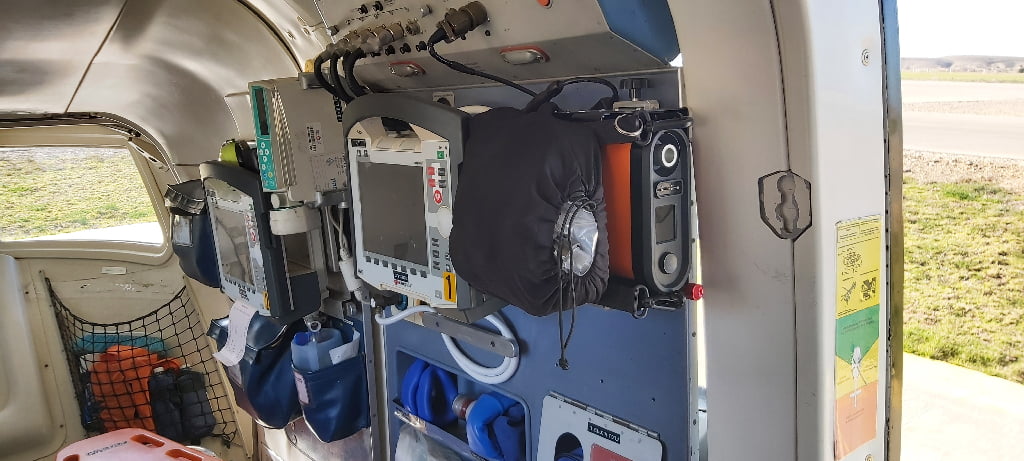
Photo/Zeltser Kobi
Description
Mechanical ventilation is often indispensable for prehospital and in-hospital transportation of critically ill patients.1 Transportation of critically ill patients requiring mechanical ventilation requires clinical experience, adequate equipment and careful assessment of the situation. Unfortunately, most transport ventilators are either sophisticated but heavy, complex and expensive, or are light and affordable but lack essential features.
Being part of a helicopter emergency medical service (HEMS) team, I often encounter the need to ventilate my patients. Caring for a ventilated patient in a helicopter is a completely different experience than that of a ground ambulance. Appropriate expertise and equipment are needed to provide effective care in a constantly changing situation.
One of the most notable changes in the loading and unloading process, as with all patient transport there is always a potential safety risk. Extubation or tube dislocations in the context of ventilated patient transports represent a clear risk for the patient. At the same time, mounting or dismounting a patient from a helicopter reduces our ability to effectively monitor and manage the situation raising the risk of tube dislocations and patient distress.
Related
Not Just a Single Squirt: Understanding Nasal Drug Delivery
Keys to Success for Airway Management
Recently, I have begun to use the Ventway Sparrow, an electric, turbine-powered, electronically controlled, transport ventilator which weighs 1 kilogram.
I have used the Ventway Sparrow, as well as its competitors, countless times in my role as an air ambulance paramedic and found the Ventway Sparrow’s design to be a refreshing change compared to the other transport ventilators I am accustomed to working with. In my review, I will focus on the Ventway Sparrow’s general capabilities and relevance to my work as a HEMS paramedic.
When paramedics evaluate ventilators, they look at key elements such as:
- Type – Pneumatic, Piston, or
- Ease of use
- Range of physiological conditions the ventilator can accommodate – lung function, cardiac function, acute & chronic injuries,
- The ability to ventilate adult and pediatric
- Range of effective ventilation modes
- Portability – Weight, Size, Shape
- Battery life
- Alarm options and settings
- Ability to function in a demanding environment with little maintenance support
- Durability
Review
Perhaps the biggest advantages the Ventway Sparrow offers are the high-performing turbine and its size and weight. The turbine ensures uninterrupted continuous ventilation, eliminating the need to rely on oxygen supply. Additionally, being oxygen-independent for the ventilator operations means a dramatic decrease in the amount of equipment we need to carry.
The Ventway is designed for mobility. Its weight and size allow for a fast dismount from the helicopter and an increased ability to initiate ventilation. Additionally, it created more space within the helicopter for equipment, thus improving our ability to care for our patients.
Even though the ventilator’s turbine and dimensions are its most obvious attributes, its size does create several drawbacks. The ventilator’s small screen size (1.8inches) demands that paramedics need to be close to the screen to set up the ventilation process. This can be a problem at times depending on the number of people in the ambulance. Another feature that should be improved is the external oxygen mixer which requires carrying additional equipment.
While the size creates some ease-of-use drawbacks (as mentioned before) I was still impressed with its usability. Ventilator usability directly affects the ability of the medical staff to provide adequate care to the ventilated patient. Human/machine interface design and the user-friendliness of ventilators are relevant to the occurrence of operational failures and increased mental workload, as been demonstrated by four independent studies.2, 3, 4, 5
Recent guidelines in the area state that, “Biomedical systems and ergonomic improvements are necessary to generate the appropriate design requirements, in response to health-care constraints, and such ergonomic studies with sufficient input from clinicians should be a priority for manufacturers.”6 In this aspect, the Ventway Sparrow has been designed with just one rotating button eliminating the need to navigate through a multitude of buttons and keys.
From a functionality point of view, the Ventway Sparrow can support patients greater than 5 kilogram in weight, providing invasive and non-invasive volume and pressure-controlled synchronized intermittent mandatory ventilation, continuous positive airway pressure, synchronized CPR, and high-flow nasal cannula while measuring and displaying exhaled tidal volumes. In addition to its ventilatory modes and functionality, the Ventway allows the caregiver to administer a manual breath on demand, a very useful feature to evaluate tube placement.
As a result of the design, the time to start ventilation is low. When reviewing the current standard operating procedures most EMS use, we see that manual ventilation using a manual resuscitator is still one of the most common methods to ventilate intubated patients during transport. Recent studies indicate that manual ventilation maintained a physiologic ETCO2 only 16.7% of the time.7 Significant variability existed, resulting in intermittent hypoxia and hyperventilation. From my experience, the time to start ventilation was similar to what to that of the manual resuscitator without the need to compromise on the quality of ventilation.
Conclusion
The Ventway Sparrow is ideal for air and land ambulances that deal with ventilated patients. Compared to other mechanical ventilators it is easier to use and smaller. Many paramedics are not comfortable when tasked with operating ventilators with complicated user interfaces. While change is always difficult, we should always look for new solutions that will better the care we provide to our patients, and based on my experience the Ventway Sparrow is one of those solutions.
References
- Hajjej Z, Gharsallah H, Boussaidi I et al (2015) Risk of mishaps during intrahospital transport of critically ill patients. Tunis Med 93: 708-713.
- Waydhas C. Intrahospital transport of critically ill patients. Crit Care 1999;3(5): R83-R89.
- Uzawa Y, Yamada Y, Suzukawa M. Evaluation of the user interface simplicity in the modern generation of mechanical ventilators. Respir Care 2008;53(3): 329-337.
- Vagnaux l, Tassaux D, Jolliet P. Evaluation of the user-friendliness of seven new generation intensive care ventilators. Intensive Care Med 2009; 35(10):1687-1691.
- Gonzalez-Bermejo J, Laplanche V, Husseini FE, Duguet A, Derenne JP, Similowski T. Evaluation of the user-friendliness of 11 home mechanical ventilators. Eur Respir J 2006;27(6):1236-1243.
- Marjanovic N, L’Her A Comprehensive Approach for the Ergonomic Evaluation of 13 Emergency and Transport Ventilators: Respir Care 2016;61(5):632–639.
- McLachlan, B., Bilbrey, C., Mausner, K., & Lenz, T. J. (2019). Effectiveness of Manual Ventilation in Intubated Helicopter Emergency Services-Transported Trauma Air medical journal, 38(4), 273–275.
For over 22 years, I have been serving as a paramedic at one of Israel’s national EMS organizations. I hold a bachelor’s degree in emergency medical services and am certified as a flight paramedic by the LIFE STAR program at Hartford Hospital, Connecticut.


